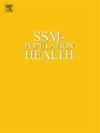Impact of domestic violence legislation on reported intimate partner violence: a difference-in-differences analysis across 16 countries
IF 3.1
2区 医学
Q1 PUBLIC, ENVIRONMENTAL & OCCUPATIONAL HEALTH
引用次数: 0
Abstract
Background
Intimate partner violence (IPV) is a highly prevalent threat to women's health globally. Domestic violence (DV) legislation – encompassing criminal sanctions and civil remedies – has been implemented in many countries but evidence on its effects are lacking. In this study, we evaluate the impact of national-level DV legislation on married women's IPV victimization.
Methods
We used self-reported IPV information from 183,222 women across 16 countries, collected in repeated cross-sectional surveys (2000–2021) by the Demographic and Health Surveys, which we linked to DV legislation information from the World Bank. We evaluated impact with a staggered difference-in-differences approach and controlled for time-varying country-level factors.
Results
Adoption of DV legislation resulted in an increase in any reported IPV (average treatment effect on the treated (ATT) = 0.07, 95 % CI: 0.00, 0.14). All investigated types of IPV increased slightly, including physical (ATT = 0.05, 95 % CI: −0.05, 0.15), sexual (ATT = 0.04, 95 % CI: −0.03, 0.10), and psychological IPV (ATT = 0.02, 95 % CI: −0.04, 0.08), although estimates were imprecise and included the null. Further assessment shows that reported IPV increased more soon after adoption of legislation, and that women with accepting attitudes about IPV experienced the greatest increase in IPV. We did not observe effect heterogeneity by other factors including age, education level, or number of children.
Conclusions
Adoption of DV legislation may increase women's reported IPV victimization. Future research could explore effect heterogeneity across multiple socio-demographic subgroups and the potential mechanisms through which such policies may benefit women's health.
家庭暴力立法对报告的亲密伴侣暴力的影响:跨16个国家的差异分析
最终伴侣暴力(IPV)是对全球妇女健康的一个非常普遍的威胁。包括刑事制裁和民事补救在内的家庭暴力立法已在许多国家实施,但缺乏关于其效果的证据。在本研究中,我们评估国家层面家暴立法对已婚妇女家暴受害的影响。方法:我们使用了来自16个国家的183,222名妇女的自我报告的家庭暴力信息,这些信息是由人口与健康调查(2000-2021)在重复横断面调查中收集的,我们将其与世界银行的家庭暴力立法信息联系起来。我们采用交错差中差方法评估影响,并控制了随时间变化的国家层面因素。结果DV立法的采用导致所有报告的IPV增加(平均治疗效果(ATT) = 0.07, 95% CI: 0.00, 0.14)。所有被调查的IPV类型都略有增加,包括物理IPV (ATT = 0.05, 95% CI: - 0.05, 0.15),性IPV (ATT = 0.04, 95% CI: - 0.03, 0.10)和心理IPV (ATT = 0.02, 95% CI: - 0.04, 0.08),尽管估计不精确,并且包括零值。进一步的评估表明,在立法通过后,报告的IPV增加得更快,对IPV持接受态度的妇女的IPV增加得最多。我们没有观察到年龄、教育水平或儿童数量等其他因素的影响异质性。结论家庭暴力立法可能增加妇女报告的家庭暴力受害。未来的研究可以探索多个社会人口亚组的影响异质性,以及此类政策可能有利于妇女健康的潜在机制。
本文章由计算机程序翻译,如有差异,请以英文原文为准。
求助全文
约1分钟内获得全文
求助全文
来源期刊

Ssm-Population Health
PUBLIC, ENVIRONMENTAL & OCCUPATIONAL HEALTH-
CiteScore
6.50
自引率
2.10%
发文量
298
审稿时长
101 days
期刊介绍:
SSM - Population Health. The new online only, open access, peer reviewed journal in all areas relating Social Science research to population health. SSM - Population Health shares the same Editors-in Chief and general approach to manuscripts as its sister journal, Social Science & Medicine. The journal takes a broad approach to the field especially welcoming interdisciplinary papers from across the Social Sciences and allied areas. SSM - Population Health offers an alternative outlet for work which might not be considered, or is classed as ''out of scope'' elsewhere, and prioritizes fast peer review and publication to the benefit of authors and readers. The journal welcomes all types of paper from traditional primary research articles, replication studies, short communications, methodological studies, instrument validation, opinion pieces, literature reviews, etc. SSM - Population Health also offers the opportunity to publish special issues or sections to reflect current interest and research in topical or developing areas. The journal fully supports authors wanting to present their research in an innovative fashion though the use of multimedia formats.
 求助内容:
求助内容: 应助结果提醒方式:
应助结果提醒方式:


